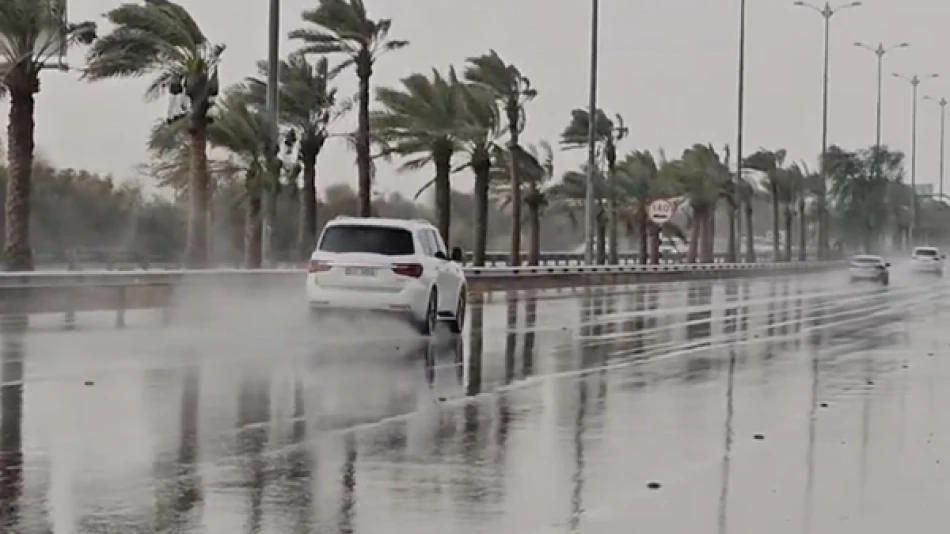
Heavy Downpours and Hail Batter Al Ain, Disrupt Everyday Life
UAE Braces for Extreme Weather as Seasonal Patterns Intensify Across Emirates
The United Arab Emirates experienced dramatic weather conditions on Thursday, with varying rainfall intensities and hailstorms hitting Al Ain city, signaling the onset of a challenging meteorological period. The National Center of Meteorology has issued safety warnings as the country enters a phase of heightened weather volatility driven by multiple atmospheric pressure systems converging over the region.
Immediate Weather Threats Prompt Safety Alerts
Thursday's weather event resulted from a weak surface low-pressure system extending from the east, combined with upper-atmosphere disturbances that created conditions for cumulonimbus cloud formation across eastern and southern regions. The meteorological center specifically warned residents to exercise extreme caution during heavy rainfall and strong wind episodes, particularly in eastern areas where flying debris and severely reduced visibility pose significant risks.
The advisory emphasized avoiding areas where water accumulates, a critical safety measure given the UAE's urban infrastructure and desert terrain, which can create dangerous flash flood conditions with minimal warning.
Complex Atmospheric Dynamics Shape Regional Climate
Multiple Pressure Systems Create Perfect Storm
The current weather patterns reflect a complex interaction of several meteorological phenomena. The Indian seasonal monsoon's extension, combined with thermal low-pressure systems from the southwest, is driving notable temperature increases across the Emirates. This atmospheric configuration, amplified by the eastern mountain ranges, creates intense daytime heating that fuels afternoon thunderstorm development.
Tropical Convergence Zone Influence
During the first half of this month, the Intertropical Convergence Zone (ITCZ) will significantly impact UAE weather patterns. This tropical weather system, known for producing intense rainfall in equatorial regions, creates conditions for sporadic but potentially severe precipitation events across the Emirates.
Seasonal Wind Patterns Reshape Daily Weather
The UAE's weather during this period is heavily influenced by land-sea breeze cycles, creating distinct daily wind patterns. Southeastern winds dominate nighttime and morning hours, while northern winds take precedence during daylight. Active southern winds, particularly strong during morning hours, frequently stir up dust storms that can impact visibility and air quality across urban centers.
Northwestern winds also periodically intensify, adding another variable to an already complex meteorological environment. These shifting wind patterns reflect the broader atmospheric instability characterizing this seasonal transition period.
Rising Humidity Signals Climate Transition
Atmospheric humidity levels are gradually increasing compared to July, with the second half of the month expected to show more pronounced changes. Current relative humidity averages around 47%, with morning and evening periods experiencing notably higher moisture levels that intensify the perceived temperature impact on residents.
Regional Climate Context and Implications
This weather pattern aligns with broader Gulf region climate trends, where traditional seasonal boundaries are becoming increasingly volatile. The UAE's experience mirrors similar challenges faced by neighboring countries like Saudi Arabia and Oman, where monsoon-influenced weather systems create unpredictable conditions during summer months.
The convergence of multiple atmospheric systems over the UAE demonstrates how the country's geographic position makes it particularly susceptible to extreme weather events. Located at the intersection of desert, maritime, and monsoon climate zones, the Emirates serves as a natural laboratory for understanding how these systems interact in an era of changing global weather patterns.
For residents and businesses, these conditions underscore the importance of weather preparedness and flexible planning during this meteorologically active period. The combination of extreme heat, sudden precipitation, and strong winds creates conditions that can rapidly shift from benign to dangerous, requiring constant vigilance and adaptive responses from both authorities and citizens.
 Layla Al Mansoori
Layla Al Mansoori







